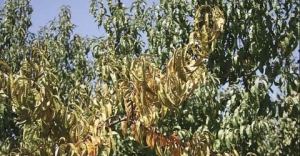
University of California’s University of California’s Scott Johnson is growing peach trees in sand boxes to induce nutrient deficiencies. These peach trees are grown without phosphorus.
Through a new research project, scientists are inducing zinc deficiencies in trees grown in sand tanks to learn more efficient ways of applying the micronutrients Zinc deficiency is a widespread problem in California peach, plum, and nectarine orchards, with corrective treatments often needed, said Dr. R. Scott Johnson, University of California Cooperative Extension pomologist. Zinc deficiency is particularly troublesome in sandy or alkaline soils.
The role of zinc in stone fruit productivity can be puzzling to plant nutritionists. Some trees with low levels show no symptoms, yet still grow vigorously, while others display traditional symptoms with reduced fruit production. Symptoms can also be mistaken for other plant disorders.
One of the first symptoms of zinc deficiency is interveinal mottling, according to the UC’s Web site on stone fruit nutrient deficiencies. The mottling closely resembles manganese deficiency and can also be confused with iron chlorosis. More severe symptoms include “little leaf,” a symptom sometimes confused with glyphosate (Round-up) herbicide damage. The leaves can have a wavy margin. Extreme deficiency can result in defoliation of basal leaves and reduce fruit production from sparse flowering, and poor fruit set.
“The current practice is to apply regular, corrective treatments of zinc in the fall or dormant period, and again in the spring if you think there’s a problem,” he said. “But we have to be careful about overapplication. Zinc is a heavy metal, and we may have problems years down the road.”
Johnson recently initiated a zinc deficiency study funded by the Fertilizer Research and Education Program, a program of the California Department of Food and Agriculture that is supported by a mil tax on fertilizer sales. He is evaluating several practices to promote better tree uptake of zinc applications as well as studying different levels of zinc deficiencies.
As Johnson searches for different practices to improve zinc uptake in the tree, he sees promise in putting a cheeseclothbag filled with sulfur into the tree hole at planting time. Johnson believes this may be an easy and economical way to lower soil pH (zinc is more readily available at lower pHs) and overcome zinc deficiencies in young trees. Stone fruit trees on Nemaguard rootstock, especially young trees, are sensitive to zinc deficiencies, because the Nemaguard root system is coarse instead of fine and has difficulty taking up zinc from the soil.
Another practice under study is planting barley near trees to learn if barley roots will capture zinc for the trees. Rootstocks are also under evaluation; some rootstocks have been observed to take up more zinc than others.
Partition studies
He is also working with Zn68, a zinc sulfate isotope that helps researchers track zinc uptake in trees. The isotope is used in partition studies to learn which parts of the tree take up the micronutrient and when. Johnson started using young seedlings grown in the UC greenhouse in 2005 as a way to speed up the partition studies. Seedlings can be cut up and chopped for leaf and other analyses faster and easier than full-sized trees in the field. Before switching to the greenhouse seedlings for the partition studies, it took a research technician an entire day to collect all the leaves from a two-year-old tree.
Through work with the zinc isotope, they have learned that the micronutrient is quite mobile within the tree, but uptake is minimal. Only 7 percent of what is applied as a fall foliar application goes from the leaves into the tree, he said, with half of the 7 percent (3.5 percent) moving into the roots. In the spring, zinc moves readily back into new growth.
Johnson’s zinc research is also evaluating best application strategies. Thus far, the partition studies show that soil applications of zinc may be inefficient because the micronutrient is easily tied up in the soil.
“I think we will find foliar applications will still be the best way to go. Hopefully, we will find ways to increase the uptake from a few percent to at least 10 to 15 percent.”

Leave A Comment